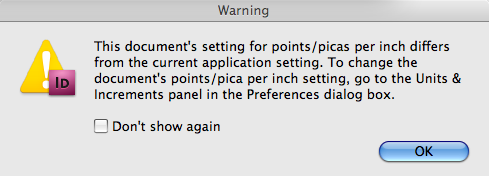I’m analysing some InDesign files for a customer presently, and upon opening one of the files in InDesign the following dialog appeared. “This document’s setting for points/picas per inch differs from the current application setting. To change the document’s points/pica per inch setting, go to the Units & Increments panel in the Preferences dialog box”.

In all honesty it wasn’t a Warning dialog I had ever encountered before.
Basically it means that in the Units & Increments section of the InDesign Preferences dialog, the points/pica size reference was changed from the default “PostScript (72 pts/inch)” to “Traditional (72.27 pts/inch)“.

This particular preference setting was introduced in InDesign CS2, possibly for the reason of giving the “Traditionalist” the choice to stick to their old measurement systems. Changing the setting back to the default “PostScript” will likely result in seeing some very irregular point-sizes 🙂
As someone who’s gone through conversion from conventional typesetting systems to Desktop Publishing based on PostScript ‘points’ (yes, I am THAT old!), I remember that our first conversions of publications from typesetting systems to our then desktop application (QuarkXPress) caused some pain in getting the point sizes/leading right.
Especially where conversion was for the purpose of reprint. The text sizing, leading etc. needed to resemble the original as closely as possible. The original jobs were set using Didot points and originated from our Berthold typesetting system. The Didot points (12 points in a Cicero), was a point system based on the “pie de roi” and French inches. Hermann Berthold adopted this system and adapted it to the metric system later on.
Basically I remember us continuously setting small print samples at various sizes, making tiny size adjustments and then comparing the printouts with type set in the previous system. Newer jobs (and I’m talking about the late 1980s), would adopt the new point system and over a period of some years this difficult conversion process was gradually phased out and we were traditionalists no more…
This really makes me wonder why in 2009 I would be opening an InDesign file that has the points/pica size settings changed to “Traditional”… I dare not ask!
Hi Kimberly.
Ha, so the error still pops up in 2011. Wow. That is amazing 🙂 Yup kids today no longer know what floppy disks are 😉 A little nostalgia pops up thinking about that 🙂
Cari, Thank you for explaining this InDesign “error” message. Now, I understand how to fix it…
I, too, learned my type setting using points and picas. Computer desktop publishing was in it’s infant stages while I was in school in the late 80’s – early 90’s when we carried around the actual programs on REAL floppy disks!
Ahhh, the memories of point/pica conversion!